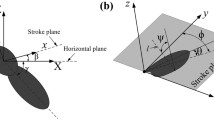Summary
-
1.
The wing beat ofCalliphora was observed stroboscopically in tethered flight. Two synchronized video cameras filmed the macroscopic wing movements and the microscopic events in the wing articulation.
-
2.
The radial stop (RS) never contacts the pleural wing process (PWP) during the upper turning of the wing. This is in contradiction to Pfau's models (1973, 1985, 1987) of the gear change mechanism.
-
3.
The contact of the RS and the PWP during the lower half of the wing cycle occurs only rarely. To describe normal flight (no contact at all), the novel models of dipteran wing beat (Miyan and Ewing 1985 a, b, 1988; Ennos 1987) have to be modified.
-
4.
Three basic operating modes of the wing articulation were observed during the lower half of the wing cycle (Fig. 2): The RS engages in the posterior (mode 1) or in the anterior (mode 2) groove of the PWP, or the RS moves into a cleft anterior of the PWP without touching the latter (mode 3). A fourth mode (mode 0: The RS stays behind the PWP) is seldomly observed and seems to be rather unphysiological. The correlation of the modes with the peaks in the downstroke amplitude distribution (Fig. 5) indicates that in modes 1 and 2 the PWP acts as a wing stop during downstroke.
-
5.
The amplitude can also be reduced during mode 3 (variant mode 3h). The contact with the PWP is not necessary for the reduction of the downstroke amplitude (Fig. 7).
-
6.
In most spontaneous maneuvres observed, unilateral mode change to mode 3h, 2, or 1 resulted in reduced downstroke amplitudes and delayed supination at the lower turning point (Figs. 3d, 6). The possible involvement of the different modes in the separation of roll- and yawtorque production is discussed.
-
7.
It is discussed which muscles and sclerites might produce the mode changes.
Similar content being viewed by others
Abbreviations
- M.b1 :
-
anterior basalar muscle
- M.b2 :
-
sternobasalar muscle
- M.I1-2 :
-
muscles of the axillare 1
- M.III1-4 :
-
muscles of the axillare 3
- PtC :
-
pterale C
- PWP :
-
pleural wing process
- RS :
-
radial stop
References
Boettiger EG, Furshpan E (1952) The mechanics of flight movements in Diptera. Biol Bull Mar Biol Lab (Woods Hole) 102:200–211
Ennos AR (1987) A comparative study of the flight mechanism of Diptera. J Exp Biol 127:355–372
Faust R (1952) Untersuchungen zum Halterenproblem. Zool Jahrb Physiol 63:325–366
Götz KG, Hengstenberg B, Biesinger R (1979) Optomotor control of wing beat and body posture inDrosophila. Biol Cybern 35:101–112
Heide G (1971 a) Die Funktion der nicht-fibrillären Flugmuskeln vonCalliphora. I. Lage, Insertionsstellen und Innervationsmuster der Muskeln. Zool Jahrb Abt Allg Zool Physiol 76:87–98
Heide G (1971 b) Die Funktion der nicht-fibrillären Flugmuskeln vonCalliphora. II. Muskuläre Mechanismen der Flugsteuerung und ihre nervöse Kontrolle. Zool Jahrb Abt Allg Zool Physiol 76:99–137
Heide G (1975) Properties of a motor output system involved in the optomotor response in flies. Biol Cybern 20:99–112
Heide G (1983) Neural mechanisms of flight control in Diptera. In: Nachtigall W (ed) BIONA-report 2. Fischer, Stuttgart New York, pp 35–52
Hengstenberg R, Sandeman DC, Hengstenberg B (1986) Compensatory head roll in the blowflyCalliphora during flight. Proc R Soc Lond B 227:455–482
Hirth C (1981) Elektrophysiologische Untersuchungen über die Bildung der Impulsmuster in den neuromotorischen Systemen nicht-fibrillärer Flugmuskeln von Schmeißfliegen (Calliphora). Dissertation, Universität Düsseldorf
Hirth C, Heide G (1980) Der Einfluß der mechanoreceptorischen Afferenzen auf das Aktivitätsmuster nicht-fibrillärer Flugsteuermuskeln vonCalliphora. Verh Dtsch Zool Ges 73:340
Miyan JA, Ewing AW (1984) A wing synchronous receptor for the dipteran flight motor. J Insect Physiol 307:567–574
Miyan JA, Ewing AW (1985a) Is the ‘click’ mechanism of dipteran flight an artefact of CCl4 anaesthesia? J Exp Biol 116:313–322
Miyan JA, Ewing AW (1985b) How Diptera move their wings: a re-examination of the wing base articulation and muscle systems concerned with flight. Phil Trans R Soc Lond Ser B 311:271–302
Miyan JA, Ewing AW (1988) Further observations on the dipteran flight: details of the mechanism. J Exp Biol 136:229–241
Nachtigall W (1966) Die Kinematik der Schlagflügelbewegungen von Dipteren. Methodische und analytische Grundlagen zur Biophysik des Insektenfluges. Z Vergl Physiol 52:155–211
Nachtigall W, Roth W (1983) Correlations between stationary measurable parameters of wing movement and aerodynamical force production in the blowfly (Calliphora vicina R.-D.). J Comp Physiol 150:251–260
Nalbach G (1985) Die Haltere als Drehsinnesorgan. Wiss. Arbeit, FB Biologie, Universität Tübingen
Nalbach G (1988 a) How doesCalliphora use the gear change mechanism during flight steering? Verh Dtsch Zool Ges 81:352
Nalbach G (1988b) Linear oscillations elicit haltere mediated turning illusions and entrainment in the blowflyCalliphora. In: Elsner N, Barth FG (eds) Sense organs. Interfaces between environment and behavior. Thieme, Stuttgart New York, p 131
Pfau HK (1973) Fliegt unsere Schmeißfliege mit Gangschaltung? Naturwissenschaften 60:160
Pfau HK (1985) Zur funktionellen und phylogenetischen Bedeutung der ‘Gangschaltung’ der Fliegen. Verh Dtsch Zool Ges 78:168
Pfau HK (1987) Critical comments on a ‘novel mechanical model of dipteran flight’ (Miyan and Ewing 1985). J Exp Biol 128:463–468
Ritter W (1911) The flying apparatus of the blowfly. Smithson Misc Collect 56:1–76
Srinivasan MV (1977) A visually evoked roll response in the house fly. Open-loop and closed-loop studies. J comp Physiol 119:1–14
Wisser A (1988) Wing beat ofCalliphora erythrocephala: turning axis and gearbox of the wing base (Insecta, Diptera). Zoomorphology 107:359–369
Wisser A, Nachtigall W (1984) Functional-morphological investigations on the flight muscles and their insertion points in the blowflyCalliphora erythrocephala (Insecta, Diptera). Zoomorphology 104:188–195
Zanker JM (1987) Über die Flugkrafterzeugung und Flugkraftsteuerung der FruchtfliegeDrosophila melanogaster. Dissertation, Universität Tübingen
Author information
Authors and Affiliations
Rights and permissions
About this article
Cite this article
Nalbach, G. The gear change mechanism of the blowfly (Calliphora erythrocephala) in tethered flight. J. Comp. Physiol. 165, 321–331 (1989). https://doi.org/10.1007/BF00619351
Accepted:
Issue Date:
DOI: https://doi.org/10.1007/BF00619351



